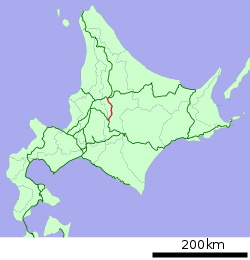Furano Line
The Furano Line (富良野線, Furano-sen) is part of the Hokkaido Railway Company network in Hokkaidō, Japan. It connects Furano Station in the city of Furano and Asahikawa Station in the city of Asahikawa. Popular with tourists, it has recently come to serve commuters in the bedroom towns that are developing as suburbs of Asahikawa.
| Furano Line | |||
|---|---|---|---|
 Kiha 150 Diesel Multiple Unit on the Furano Line. | |||
| Overview | |||
| Type | Heavy rail | ||
| Status | Operational | ||
| Locale | Hokkaido, Japan | ||
| Termini | Asahikawa Furano | ||
| Stations | 18 | ||
| Operation | |||
| Opened | 1899 | ||
| Operator(s) | Hokkaido Railway Company | ||
| Technical | |||
| Line length | 54.8 km (34.1 mi) | ||
| Track gauge | 1,067 mm (3 ft 6 in) | ||
| Operating speed | 85 km/h (55 mph) | ||
| |||
History
The Furano Line opened on September 1, 1899, as the Hokkaidō Kansetsu Railway (北海道官設鉄道, Hokkaidō Kansetsu Tetsudō), operating between Asahikawa and Biei Stations. In the next month, service extended to Kami-Furano Station, and in the following year it reached Shimo-Furano Station.
In 1909 it became part of the Nemuro Main Line from Asahikawa Station to Kushiro Station, but in 1913 it took its present name and covered the route from Asahikawa Station to Shimo-Furano Station. The eruption of Mount Tokachi on May 24, 1926, caused a protracted interruption of service between Biei and Kami-Furano. In 1942, Shimo-Furano Station changed its name to Furano Station.
On April 1, 1987, with the breakup of the Japanese National Railways, the line became part of the Hokkaido Railways. In 2007, the station-numbering plan took effect.
On November 19, 2016, JR Hokkaido's President announced plans to rationalise the network by up to 1,237 km, or ~50% of the current network,[1] including the proposed conversion to Third Sector operation of the Furano Line, but if local governments are not agreeable, the line will face closure.
Former connecting lines
The private Asahikawa Electric Railway line to Higashikawa (15.5 km) branched from the Furano line south of Asahikawa station, operating from 1927-73. A 6.7 km branch to Asahiyama Park operated from 1930-73. Both lines were electrified at 600 V DC.
Operations
All trains are local trains within the Furano Line. One train continues past Furano to Obihiro Station as a Karikachi Express train; the rest operate only within the Furano Line, half covering the route between Asahikawa and Biei. Nearly all rolling stock is KiHa 150 Diesel Multiple Units.
Stations
Station numbers, names, other lines serving the stations and line distances from Asahikawa are as follows. Asterisks denote two-track stations where trains can pass.
| No. | Station name | Japanese | Distance (km) | Passing loop | Transfers |
|---|---|---|---|---|---|
| A28 | Asahikawa | 旭川 | 0.0 | n/a[Note 1] | ■ Hakodate Main Line ■ Sekihoku Main Line ■ Sōya Main Line |
| F29 | Kaguraoka | 神楽岡 | 2.4 | ||
| F30 | Midorigaoka | 緑が丘 | 4.0 | ||
| F31 | Nishi-Goryō | 西御料 | 5.2 | ||
| F32 | Nishi-Mizuho | 西瑞穂 | 7.4 | ||
| F33 | Nishi-Kagura | 西神楽 | 9.9 | + | |
| F34 | Nishi-Seiwa | 西聖和 | 12.3 | ||
| F35 | Chiyogaoka | 千代ヶ岡 | 16.6 | + | |
| F36 | Kita-Biei | 北美瑛 | 20.3 | ||
| F37 | Biei | 美瑛 | 23.8 | + | |
| F38 | Bibaushi | 美馬牛 | 30.6 | + | |
| F39 | Kami-Furano | 上富良野 | 39.7 | + | |
| F40 | Nishinaka | 西中 | 44.2 | ||
| F41 | Lavender Farm (open seasonally) | ラベンダー畑 | 45.8 | ||
| F42 | Naka-Furano | 中富良野 | 47.3 | + | |
| F43 | Shikauchi | 鹿討 | 49.7 | ||
| F44 | Gakuden | 学田 | 52.5 | ||
| T30 | Furano | 富良野 | 54.8 | + | ■ Nemuro Main Line |
- Asahikawa station is part of the double-tracked Hakodate Main Line.
References
- "JR Hokkaido says it can't maintain half of its railways". May 10, 2013.
- This article incorporates material from 富良野線 (Furano-sen) in the Japanese Wikipedia, retrieved on June 22, 2019.
